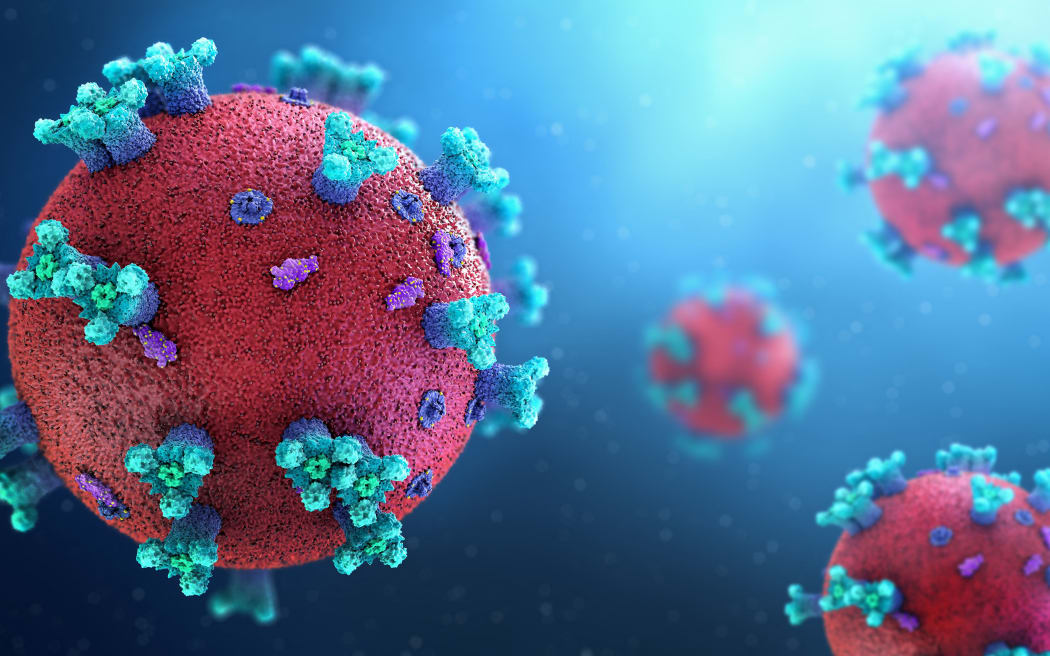
Covid-19 cases are up across Aotearoa, but hospitalisations are trending down. Photo: AFP / Science Photo Library
A highly mutated Omicron variant has been responsible for more than nine in 10 New Zealand coronavirus infections - making it easily the most dominant strain in more than a year.
ESR's latest surveillance showed the JN.1 variant accounted for 93 percent of coronavirus detected through wastewater sampling, along with three-quarters of sequenced samples from hospitals.
Covid-19 modeller Professor Michael Plank said a single variant had not caused such an impact since the Omicron off-shoot BA.5 caused a mid-winter wave in mid-2022.
First picked up here in October, JN.1 was making up about one in 10 cases by the start of December and at least half by the end of that month, before becoming the driving sub-variant in New Zealand's summer surge.
Its rise marked a dramatic shift from local Covid-19 patterns over the last year and a half, in which cases had been caused by a "soup" of Omicron sub-variants circulating together.
"We always knew this was a possibility, but we didn't know for sure whether it was going to happen or not," Plank said of JN.1′s dominance.
The sub-variant emerged from a similarly-mutated Omicron strain, BA.2.86 - of which JN.1 was separated by just a single mutation in the spike protein the virus used to enter our cells.
A descendant of JN.1 - JN.1.4 - has since been detected in New Zealand and overseas, but was thought to have only an incremental advantage over its parent.
"Although this is the first time in 18 months that we've had a variant sweep through, it hasn't had anything like the health impact that BA.5 did," Plank said.
https://t.co/9laKzeabLC NZ wastewater COVID-19 surveillance. By end Jan, almost complete takeover (93%) by variant 'JN.1' (all lineages with a JN.1 spike protein). Overall, SARS-CoV-2 levels lower than a month or so ago despite a slight uptick last week. pic.twitter.com/DwMcB1H3Hv
— Joanne Hewitt (@joannehewittnz) February 9, 2024
"It's clearly got a growth advantage and some degree of immune advantage, but it's not causing the same level of severe illness that we saw in the past."
The difference partly owed to more people having been exposed to the virus since 2022, he said.
Otago University evolutionary virologist Dr Jemma Geoghegan said JN.1 was similarly dominant elsewhere in the world, indicating Covid-19 had not settled into a seasonal pattern like other respiratory diseases.
"This shows that we're still in these pandemic waves, driven by the evolution of the virus."
While surveillance showed Covid-19 infection rates remained elevated across New Zealand, there were indications the country was past the peak of the wave, with hospitalisations and wastewater detections trending downward nationally.
Te Whatu Ora's latest update showed 245 Covid-19 cases in hospital at midnight Sunday - around half the number reported in mid-January.
Just as JN.1 helped add momentum to the surge, Plank said it was also possible it could shorten its tail - meaning the wave's decline might not prove as gradual as its build-up.
The latest Omicron-targeted booster was not yet available in New Zealand, despite being in use elsewhere - but experts said the current shot remained effective in preventing severe disease.
This story was first published by the NZ Herald.






